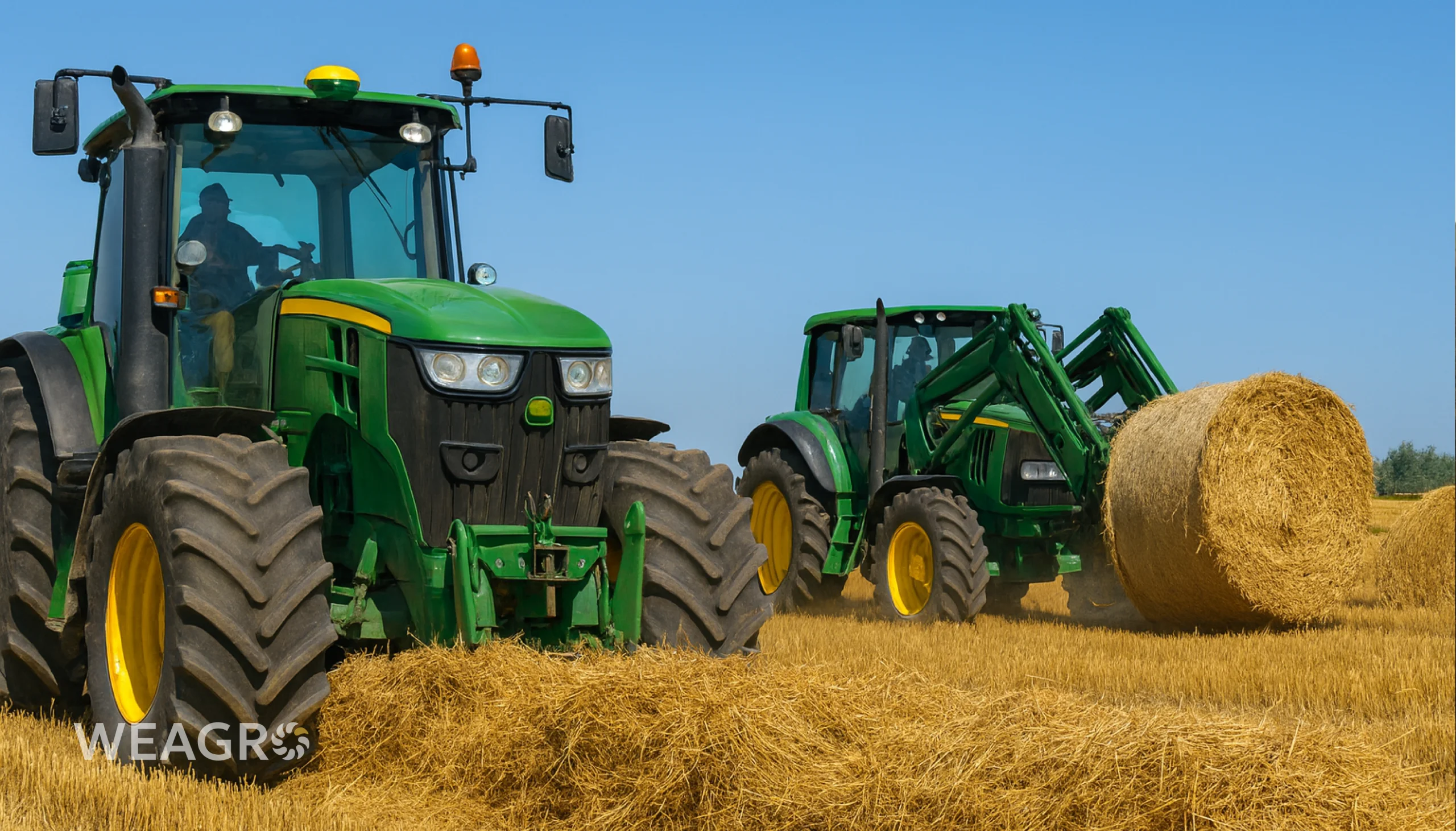Typical fuel consumption rates for tractors in agriculture are an important indicator that determines the amount of fuel consumed by machinery during work. Let’s take a closer look at what typical values are and how to calculate them correctly. This article will be useful for farmers who use tractors, gasoline-powered mowers, loaders, and other agricultural machinery.
Why It’s Necessary to Calculate Fuel Consumption Rates for Agricultural Machinery
Calculating typical fuel consumption rates for tractors in agriculture is necessary for several reasons:
- planning the farm’s need for fuel and lubricants for a certain period (month, quarter, year) taking into account the volume of work;
- monitoring actual fuel limits and identifying deviations from planned indicators;
- keeping records and reporting on the use of fuel and lubricants, justifying expenses;
- rational use of available fuel resources, searching for savings reserves and optimization;
- standardizing the work of machine operators, determining the cost of mechanized work;
- analyzing the efficiency of machinery use, comparing different technologies and units.
Establishing justified usage standards allows agricultural producers to optimize the operation of units, control resources, avoid inappropriate use of fuel, which ultimately reduces production costs, increasing production profitability.
Read also: Production cost: what it is, calculation formula
Options for Establishing Fuel Consumption Rates
There are several options for establishing typical fuel consumption rates for tractors in agriculture.
Using Special Collections of Norms
The Ukrainian Research Institute of Productivity of the Agro-Industrial Complex of the Ministry of Agrarian Policy (Research Institute “Ukragropromproduktivnist”) and regional research centers of agricultural productivity issue methodological and practical collections of fuel consumption limits. Among them:
- methodological provisions and norms of productivity and fuel consumption for fertilizer application, protection of agricultural crops (2017);
- methodological provisions and norms of productivity and consumption of electricity and fuel for irrigation of agricultural crops (2015);
- methodological provisions and norms of productivity and fuel consumption for harvesting agricultural crops (2014);
- methodological provisions and norms of productivity and fuel consumption for soil cultivation (2014);
- methodological provisions and norms of productivity and fuel consumption for sowing, planting and crop care (2014).
The collections contain scientifically based norms of fuel consumption for agricultural work for various types of activities and units, taking into account specific natural production conditions, technologies, specific fuel limits, etc. The norms are differentiated by tractor brand, type of work, soil type, aggregation scheme.
These normative publications can be purchased at zonal and regional productivity centers. Contact details are provided on the website of the Research Institute “Ukragropromproduktivnist”.
Development of Individual Norms
If the collections do not contain standards for specific equipment or work performed by the enterprise, or do not take into account its specifics, you can order the development of individual norms from the Research Institute “Ukragropromproduktivnist” or its regional centers. To do this, it is necessary to provide initial data on equipment, conditions and scope of work.
Developed individual limits are approved by the head of the enterprise and registered with the Research Institute “Ukragropromproduktivnist”. Such limits will only be valid for a specific customer and cannot be borrowed by other enterprises.
The advantage of this option is taking into account the unique conditions and features of the business. However, developing individual standards requires additional costs and takes some time.
Using Typical Norms from Documents
Partially, in particular for tractors, typical fuel consumption standards can be applied from the following documents:
- DBN V.2.8-12-2000 “Typical norms of fuel and lubricant consumption for the operation of equipment in construction”, approved by the Order of the State Construction Committee of Ukraine dated January 12, 2000, No. 9.
- Limits of fuel and lubricant consumption for the operation of road construction and special machines H218 “Ukravtodor” 043-96, approved by the Order of the “Ukravtodor” Corporation dated August 14, 1996, No. 156.
These documents provide fuel consumption standards for different tractor models (tracked, wheeled) in kilograms or liters per machine-hour of operation. They are differentiated by engine power.
However, it should be taken into account that these indicators were developed for equipment used mainly in construction and road management. They do not take into account the specifics of many agricultural works.
Independent Development of Norms
If an enterprise is unable to use ready-made norms or order their development, it can independently develop and implement its own fuel consumption indicators. To do this, it is necessary to conduct time studies of equipment operation in real conditions.
The methodology for developing own fuel consumption limits for mechanized work in agriculture is given in DSTU 4397:2005 “Methods of economic evaluation of equipment at the testing stage”. According to it, the following actions need to be performed:
- Determine the volume of mechanized work for which norms are being developed, in natural indicators (ha, t, tkm).
- Measure fuel consumption experimentally using a flow meter directly during work performance in typical conditions.
- Conduct a time study of the unit’s operation, determine the duration of the shift, net working time, downtime, idle movements, etc.
- Calculate fuel consumption standards per unit of work by dividing total consumption by the volume of work performed.
- Conduct at least three control shifts and determine the average value.
- Formalize the observation results with a bilateral act and approve by order of the enterprise head.
Independently developed norms will be maximally adapted to the specific conditions of the farm, but require organizational efforts and time expenditure. The qualification of performers and metrological support of measurements should also be taken care of.
Regardless of the origin of the norms, the fact of their application must be recorded by the order of the head and brought to the attention of work performers.
Read also: Environmental Tax in Ukraine: What It Is and Who Must Pay It
How to Independently Calculate Fuel Consumption Rates for Agricultural Machinery
If it is not possible to use ready-made norms or order their development, limits can be determined independently by calculation method or using control measurements. Let’s consider a few examples.
Example 1
It is necessary to calculate fuel consumption standards for a T-150 wheeled tractor with a diesel engine of 125 kW power. Specific fuel consumption at nominal power is 185 g/hp×h. We use the formula:
Hi= qe× Ne× C × 10-3,
where Hi is the individual fuel consumption standard, kg/mach.×h, Qe is the specific fuel consumption at nominal engine power, g/hp×h, Ne is the nominal engine power, kW, C is the integral coefficient that takes into account average operating conditions.
We determine the integral coefficient:
C = KDV× KDN× KTN× KTZ= 0.86 × 0.4 × 1.19 × 1.03 = 0.42.
Then Hi= 185 × 170 × 0.42 × 10-3= 13.2 kg/mach.×h.
Example 2
Let’s calculate the limits for the TO-28A loader with a D-260-1-114 engine with a power of 114 kW. Specific fuel consumption at nominal power is 162 g/hp×h.
Integral coefficient: C = 0.86 × 0.3 × 1.6 × 1.03 = 0.425.
Consumption limit: Hi= 162 × 155 × 0.425 × 10-3= 10.67 kg/mach.×h.
Example 3
Let’s determine temporary fuel consumption limits for the 4000M forklift based on control measurement data. According to Norms No. 43, the linear norm: H = 27.5 l/100 km, the norm for equipment operation: Heq= 5 l/h. The forklift worked for 8 hours.
Norm for equipment operation: Heq= 8 × 5 = 40 l.
We formalize the results of control measurements with an act. The temporary individual norm takes effect after registration and approval by order of the enterprise head.
To reduce tractor fuel consumption on large areas, you can optimize travel routes and avoid idle trips. It is also important to properly select engine and transmission operating modes according to operating conditions.
In the modern realities of the agricultural sector, every producer is interested in optimizing costs and increasing work efficiency. The online service WEAGRO helps solve these tasks. It offers the possibility of purchasing material and technical resources, including fuel, in installments or with deferred payment. Using WEAGRO allows farmers not to divert working capital, buy more resources, and receive discounts from suppliers.
Fuel Consumption Rates for Different Types of Agricultural Machinery
Let’s take a closer look at typical fuel consumption rates for tractors in agriculture, as well as gasoline-powered mowers, lawn mowers, and loaders.
Fuel and Lubricant Consumption Rates for Tractors
Typical fuel consumption standards for tracked and wheeled tractors depending on the model are given in DBN V.2.8-12-2000 “Typical norms of fuel and lubricant consumption for work performed mechanically”.
The indicators are differentiated by tractor brand and given in kilograms or liters per machine-hour of operation. For example, there are such fuel consumption rates for MTZ tractors and other models:
| Tractor brand | Fuel consumption rate |
| T-150K | 13.8 l/mach.×h |
| KhTZ-121 | 12.3 l/mach.×h |
| MTZ-80, MTZ-82 | 7.3 l/mach.×h |
| T-40A | 3.8 l/mach.×h |
| DT-75M | 7.6 l/mach.×h |
There are also fuel and lubricant consumption rates for tractors per 100 l of fuel consumption.
These fuel consumption rates for tractors in agriculture can be used for accounting and planning fuel consumption by tractors on various works.
Read also: Types of tractors: what they are and how to choose
Fuel Consumption Rates for Gasoline-Powered Brush Cutters
Fuel consumption by gasoline-powered brush cutters (brush cutters, brush saws) depends on the power and type of engine, operating mode, condition of the cutting apparatus, vegetation density, etc.
According to manufacturers of Stihl, Solo, Oleo-Mac brush cutters, the average fuel consumption is:
| Engine power | Fuel consumption |
| 0.7–1 kW | 0.5–0.7 l/h |
| 1–1.5 kW | 0.7–1 l/h |
| 1.5–2.5 kW | 1–1.5 l/h |
More precise fuel consumption rates for gasoline-powered brush cutters are determined experimentally in specific mowing conditions, taking into account the duration of continuous operation, breaks, refueling time, transitions, etc.
Fuel Consumption Rates for Lawn Mowers
Typical fuel consumption rates for the most common lawn mower brands:
| Lawn mower brand | Fuel consumption, l/h | Productivity, m²/h |
| Husqvarna LC 140 | 1.2–1.6 | 1200–2000 |
| MTD Smart 395 PO | 1.4–1.8 | 1400–2200 |
| Stiga Combi 55 SQ B | 1.6–2 | 1800–2500 |
To clarify fuel consumption, it is advisable to conduct control measurements on a plot with a known area, taking into account turning and maneuvering.
Fuel Consumption Rates for Loaders

Fuel consumption rates for front loaders based on wheeled tractors are given in DBN V.2.8-12-2000. For example:
| Loader model | Fuel consumption rate |
| PF-0.5 | 5.6 l/mach.×h |
| PG-0.2A | 4.5 l/mach.×h |
| PE-0.8B | 6.3 l/mach.×h |
For telescopic and other loaders, standards should be determined by calculation or experimentally, as shown in example 3.
For more accurate standardization of fuel consumption rates for loaders, it is advisable to establish them depending on the type of cargo (bulk, piece) and its characteristics (bulk density, size of piece goods) in kilograms or liters per 1 ton of processed cargo.
Conclusion
Thus, fuel consumption rates are an important indicator that needs to be controlled for efficient operation of agricultural machinery. They can be taken from industry collections, ordered for development, or determined independently by experimental means.
Using the online service WEAGRO will help agricultural producers purchase fuel and other material and technical resources for performing agricultural work with deferred payment and without collateral.









